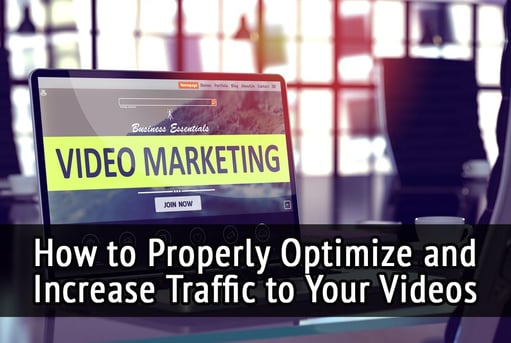This post has been updated for 2019
Over the past few weeks we have noticed an increase of folks interested in enhancing the performance of their videos. One of our readers in particular (for the sake of anonymity let’s call him Mr. Smith), underlined that he is a proud small business owner (SMB) and has seen satisfactory results from his company’s blog and social channels, however his videos seem to be severely lacking, drawing in a minuscule amount of traffic.

Using videos to bring traffic and add value to your business is a solid tactical idea. Data has shown that videos can be one of the most powerful instruments for marketers and business owners. They are a great medium to increase your online reputation, helping you gain authority in your industry, and even add more personality to your brand. However, just as any other form of content we create, if not properly planned and optimized, they will unfortunately under perform.
To help your business tap into the potential value that video offers, we’ll present insights and tactics which can transform your video marketing into a value adding, traffic generating machine.
The Multiple Layers of Video Optimization Planning
Let’s start with the planning first. There are multiple elements that you will want to accommodate in your video creation process. Let’s dig into a few below:
- Distinguishing the type of video you will be producing: For instance, are you looking to create a commercial, provide educational content, emphasize product marketing or perhaps something else? Determine this upfront and align with all of the following elements.
- Always have your audience in mind: Focus on offering them value in your video by solving a pain, need, or interest of theirs.
- Understand that different videos serve different audience: With an eye toward distribution, ensure you know where to deploy your videos to connect with the appropriate audiences.
- Video length is crucial: Research has shown that viewers tend to prefer shorter, more condensed videos. Edit down lengthy videos to include the essentials ideally keeping promotional videos around 1 minute, and educational videos in the 5 minute range.
- Videos should also be entertaining: Entertaining videos are more memorable and pleasant to watch.
- Encourage viewer engagement: You ideally want them to subscribe to your channel, like your video, and leave a comment offering their insight. Look for ways to encourage this either in the video or as part of your distribution process.
At the end of the day, you want your videos to leave a lasting impression on your audience, create a memorable experience for your viewers, and make them crave more of your content.
Video SEO
This can be a bit tricky as you are in effect looking to optimize this for the video platform you post on as well as try and get it picked up by Google too.
Step 1: The Keywords
As with any form of content, the SEO process begins with effective keyword research. This time around however, the main focus should be around “video keywords” in order to ensure optimal ranking in both YouTube and Google.
 YouTube - The process of identifying such keywords on YouTube is similar to the process used for creating any other of your content pieces.
YouTube - The process of identifying such keywords on YouTube is similar to the process used for creating any other of your content pieces.
Generating possible keywords to address – while there are multiple ways to do this, we'll just focus on a couple below:
- Use the drop-down list of recommended results offered by YouTube’s search query. That gives you a total of 10 at one time.
- Want more than 10 at a time? Use additional free tools such as answerthepublic.com and soovle.com which has a dedicated section specifically for YouTube keyword recommendations.
Evaluating the keywords – Now that you have a list of possible keywords, you need to do your best to evaluate which ones to focus on. Use tools like SEMRush.com, Hubspot.com, or Google KeywordPlanner to help your examination. It should be noted that these tools will offer you with detailed ranking information pertaining to Google’s search engine, not YouTube.
Google - The process for finding winnable keywords for Google is identical to the one mentioned above, however there is one additional element that needs attention.
From a quick search you will find that Google reserves some spots among the 10 results per page for videos that include “video keywords” (mentioned previously).
The most popular (and effective) “video keywords” are those revolving around:
- How-to’s
- Product or service reviews
- Tutorials
- Funny and entertaining videos (often involving pets or other animals)
- Anything related to sports and fitness (be it an exercise demonstration or highlights from games).
These (especially the first 3) are tightly tied to user "intent." Therefore if you want to maximize your chances of your video appearing on one of Google’s reserved SERPs you should make an effort to include keywords related to the above categories when optimizing your video.
Step 2: The Title
Having identified which video keywords are “winnable” the next element you should pay attention to is your video’s title. Try to include the full keyword but avoid “stuffing.” Ideally your title should be no longer than 70 characters. Remember, as with the title of your blog post, focus on placing your keyword at the beginning potentially increasing the video’s SEO.
Step 3: The Description
 Perhaps one of the most important (and often overlooked) optimization elements is your video’s description. This is what ultimately tells both search engines (YouTube and Google) what your video is about and plays an important role in determining your rank. You will find that a few uploaders include their video’s transcript in the description but this is not entirely necessary. You will want your description to provide value to both the search engine and the viewers.
Perhaps one of the most important (and often overlooked) optimization elements is your video’s description. This is what ultimately tells both search engines (YouTube and Google) what your video is about and plays an important role in determining your rank. You will find that a few uploaders include their video’s transcript in the description but this is not entirely necessary. You will want your description to provide value to both the search engine and the viewers.
- Provide your personal information: You can include your company’s name, your contact information, NAP (name, address, phone) and your website’s URL at the very top of the description.
- Include a concise summary of your video: Ideally between 200-300 words.
Do not forget to include your keywords here as well. Try to include them at least 3-4 times throughout the text with the first mention being within the first 1-2 sentences.
Step 4: The Tags
Another commonly overlooked element are video tags since they do not show on the face of the page, however they have significant strategic value. By including tags relevant to your keywords you are actively helping the search engines pair your video with others holding the same tags. This ultimately means that your chances of appearing in the “related videos” section are dramatically increased and potentially so will your visibility. Use ample and relevant keywords with the most relevant ones at the front of the list.
Step 5: YouTube's Metrics
 As opposed to your written content which may include backlinks for Google to analyze, YouTube uses certain metrics to determine the quality of your video (and therefore your ranking). More specifically it evaluates:
As opposed to your written content which may include backlinks for Google to analyze, YouTube uses certain metrics to determine the quality of your video (and therefore your ranking). More specifically it evaluates:
- The number of views
- Viewer retention
- Likes
- Shares
- Comments
This is why your video must provide value for your audience. You will need to make your message educational, entertaining, and memorable; only then will viewers feel inclined to start engaging with your content.
(Bonus: The YouTube search engine is becoming increasingly smarter in analyzing every element of your video so remember to add a thumbnail to every video and even optimize the title of the file you will be uploading.)
How to Increase Traffic to you Videos
 The most important element for ranking and perhaps the hardest thing to achieve is acquiring a significant amount of traffic (views) for your videos. But how can you accomplish this?
The most important element for ranking and perhaps the hardest thing to achieve is acquiring a significant amount of traffic (views) for your videos. But how can you accomplish this?
Leverage the Power of your Blog
Once having appropriately optimized your video the first thing you can do is leverage your blog for distribution. YouTube likes to see external embeds. It’s a sign of popularity. A strategic approach would be to create a blog post related to a certain video and include respective links for both pieces of content.
Leverage your Social Channels
You should also leverage your social channels. Whenever you upload a new video post about it or even provide a link for your followers. This is a sound strategic step as it allows for greater exposure. Further, if your videos offer value to your audience people might potentially begin sharing the video with others in their network who might have the same pain, need, or interest, you are actively solving with your content.
 Leverage Q&A
Leverage Q&A
Finally, if you are trying to build authority within your industry, chances are that you are actively answering your followers’ questions or even questions on other Q&A sites such as quora.com. If appropriate, try adding your video’s link to your answer (or even embed it), this will not only help enhance visibility and increase traffic, it will also allow you to provide greater value to those who posed the question as you will be providing them with a brief, informational, and entertaining response.
Leverage your Website
Another large representative of your brand and offerings which may potentially be gaining adequate visits is your website. It would therefore be smart to embed your latest video on your site’s front page for visitors to view and engage.
Final Remarks
Mr. Smith (and all our beloved readers), we hope your questions have been answered and that you will be implementing the steps proposed in this article to perfect your video marketing efforts.
Remember:
- Start with formulating a quality video aimed at addressing one subject for one type of audience in an informational but entertaining manner that will promote viewer engagement.
- If you want your video to rank for both YouTube and Google you will need to incorporate “winnable” video keywords and appropriately optimize your title, description, tags and file type.
- Finally, focus on effective distribution. Leverage your existing following, content, and authority to help enhance your videos’ visibility and divert traffic to your channel.
We look forward to your future questions and comments. You can share, like or chat about this with us on Twitter, Facebook , LinkedIn, or simply leave a comment below.
For more insight and reading on digital marketing, check out the links below
- The Art Of Repurposing Content
- 5 Steps to Make Influencer Marketing Work for You
- Content Marketing - What Does It Really Mean?
- 15 Types Of Blogs To Make Content Marketing More Effective



